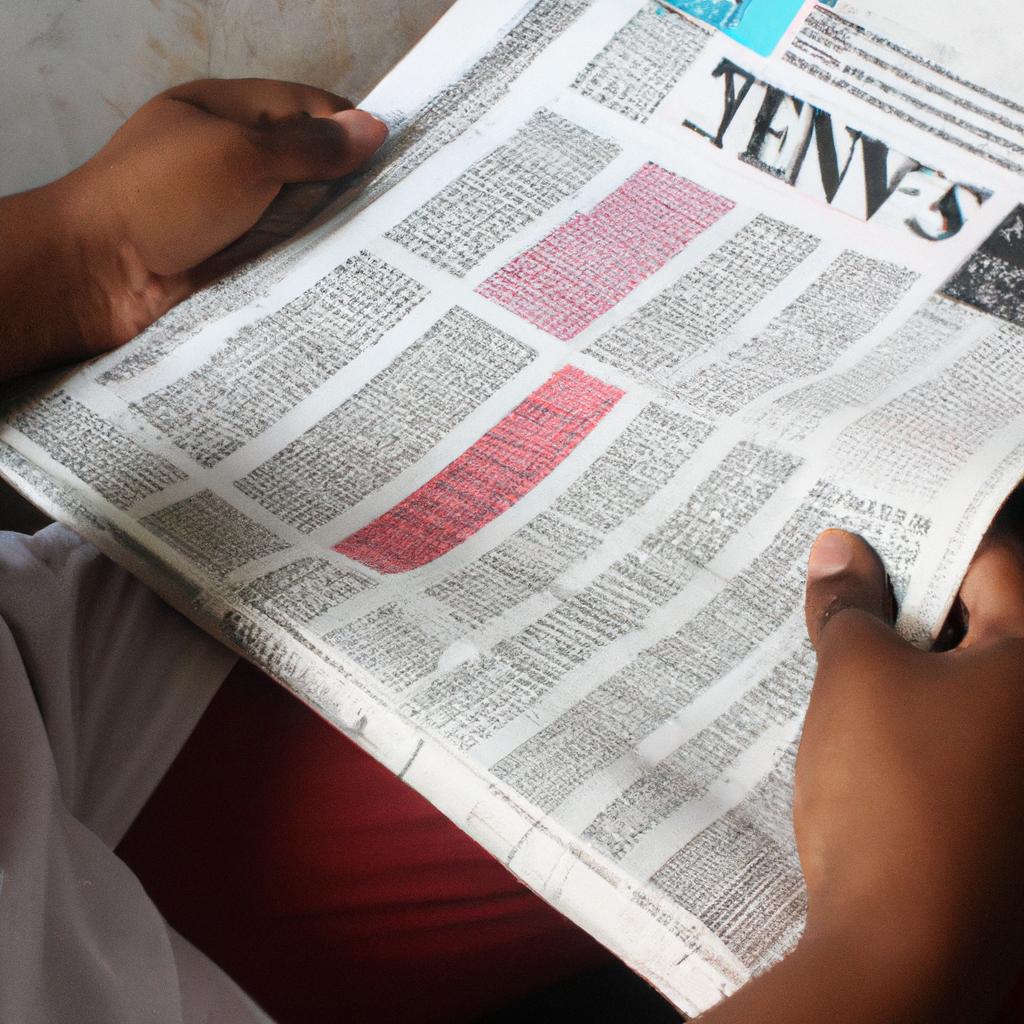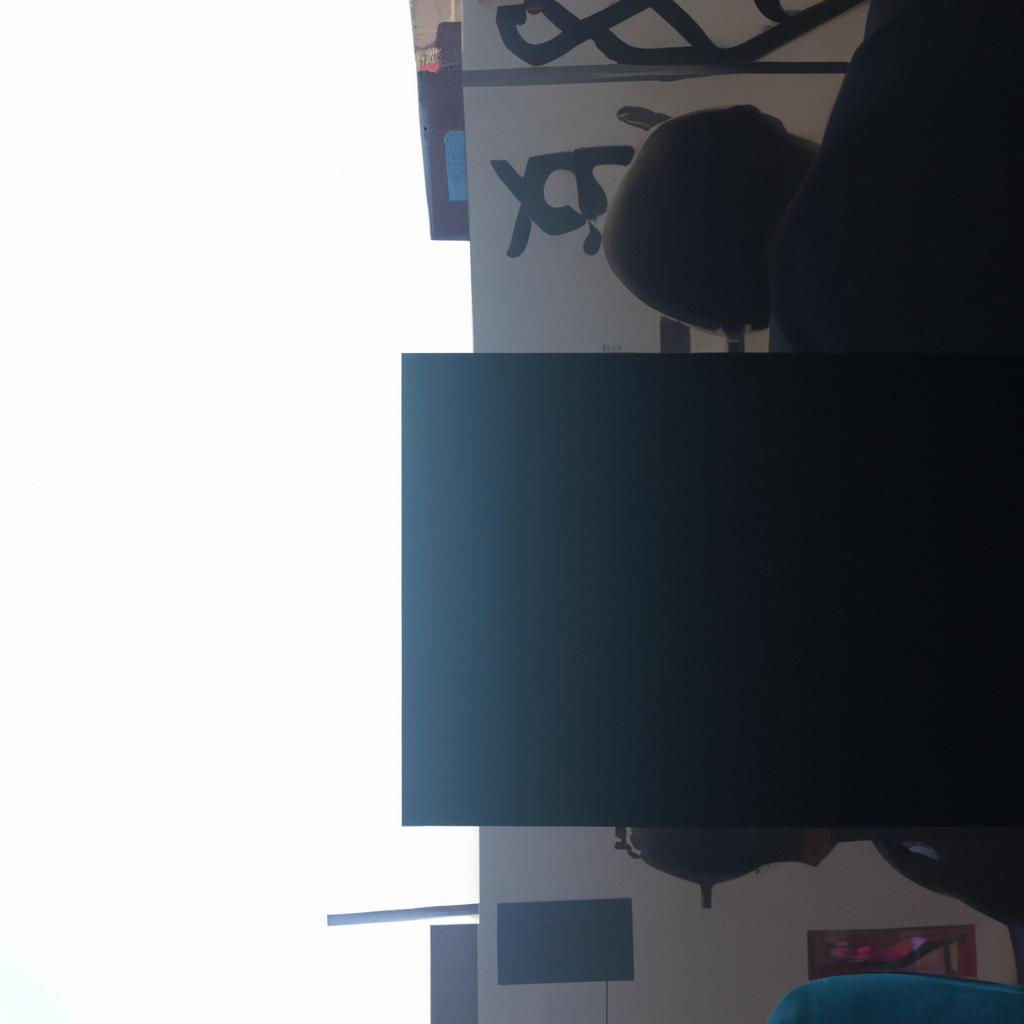In recent years, the issue of government regulation and media ownership has become a topic of increasing concern in the news media industry. The concentration of media ownership in the hands of a few powerful entities raises questions about the diversity and objectivity of news reporting. This article aims to explore the implications of government regulations on media ownership by examining a case study that highlights these concerns.
One such example is the hypothetical scenario where a large conglomerate acquires multiple newspapers, television stations, and online platforms. As this conglomerate gains control over various sources of information, there arises a potential conflict of interest. The conglomerate may prioritize their own financial interests or political agenda, thereby compromising journalistic independence and impartiality. This situation underscores the need for effective government regulations to ensure fair competition, safeguard press freedom, and maintain public trust in the news media industry.
Thus, understanding the relationship between government regulation and media ownership is crucial for comprehending how it impacts not only journalism but also democratic societies as a whole. By critically analyzing existing regulatory frameworks and exploring alternative approaches to address this issue, we can foster an environment that promotes transparency, accountability, and diverse perspectives within our ever-evolving news landscape.
Historical overview of government regulation in the news media industry
Government regulation has played a significant role in shaping the news media industry over time. This section provides a historical overview of government intervention and its impact on media ownership.
One notable example of government regulation is the Federal Communications Commission (FCC) in the United States. Established in 1934, the FCC was tasked with regulating interstate communications, including radio and television broadcasting. Through licensing requirements and ownership restrictions, the FCC aimed to ensure fair competition and prevent monopolistic practices in the broadcast industry. For instance, the FCC’s “fairness doctrine” from 1949 to 1987 required broadcasters to present contrasting viewpoints on controversial issues.
Over the years, various countries have implemented different forms of government regulation to address concerns surrounding media ownership concentration. These regulations are often put in place to safeguard pluralism, diversity, and democratic values within the news media landscape. Some common measures include:
- Ownership caps: Governments may impose limits on how many media outlets an individual or company can own within a given market.
- Cross-media ownership rules: Restrictions may be placed on owning multiple types of media platforms (e.g., print newspapers and broadcast stations) to prevent excessive control by one entity.
- Public interest obligations: Media owners may be required to fulfill certain responsibilities towards public service programming or local content production.
- Anti-monopoly laws: Governments use legislation designed to prevent mergers that would create dominant players controlling too much of the market share.
These regulatory strategies aim to strike a balance between promoting competition and ensuring diverse voices are heard within the news media industry. However, there is ongoing debate about their effectiveness and potential unintended consequences.
Table: Examples of Government Regulation Measures
| Measure | Description |
|---|---|
| Ownership Caps | Limits on how many media outlets an individual or company can own within a given market |
| Cross-Media Ownership | Restrictions on owning multiple types of media platforms (e.g., print newspapers and broadcast stations) to prevent excessive control by one entity |
| Public Interest Obligations | Responsibilities towards public service programming or local content production |
| Anti-monopoly Laws | Legislation designed to prevent mergers that would create dominant players controlling too much of the market share |
In summary, government regulation has been instrumental in shaping media ownership. Through organizations like the FCC and various regulatory measures such as ownership caps and anti-monopoly laws, governments seek to ensure fair competition, diversity, and democratic ideals within the news media industry.
This historical overview sets the stage for understanding the impact of government regulation on media ownership in subsequent sections. It provides essential context for analyzing how regulatory frameworks have influenced the structure and dynamics of the news media landscape over time.
The impact of government regulation on media ownership
To understand the implications of government regulation on media ownership, it is essential to examine specific cases that highlight its effects. One such example involves the acquisition of a major news organization by a conglomerate with close ties to political entities. This hypothetical case study illustrates how government regulations can potentially influence media consolidation and subsequently impact journalistic independence.
Effects on Media Ownership:
Firstly, government regulations play a pivotal role in shaping the concentration of media ownership. In many countries, regulatory frameworks exist to prevent monopolistic practices within the news industry. However, these regulations may not always be effective in curbing undue concentrations of power. For instance, one consequence could be the formation of oligopolies where a few dominant players control significant portions of the market. Such situations often lead to limited diversity of perspectives and reduced competition within the news landscape.
Additionally, government regulation can determine foreign investment restrictions and limit cross-ownership between different forms of media outlets. These measures aim to safeguard national interests and maintain editorial independence from external influences. Nevertheless, stringent regulations can inadvertently hinder innovation and collaboration across various platforms or impede international cooperation among media organizations.
Implications for Journalism Ethics:
The impact of government regulation extends beyond issues related solely to media ownership; it also raises concerns regarding journalism ethics and freedom of expression. When owners have strong affiliations with political entities, there is an inherent risk that editorial decisions might become biased or influenced by partisan agendas. Journalists may face pressure to align their reporting with certain narratives or avoid critical coverage that could jeopardize relationships between media owners and politicians.
- Diminished plurality in news sources
- Potential loss of impartiality
- Threats to investigative journalism
- Erosion of public trust in media institutions
Table showcasing examples:
| Examples | Implication | Consequence |
|---|---|---|
| Media consolidation | Reduced diversity of viewpoints | Limited representation of opinions |
| Biased reporting | Undermined journalistic integrity | Compromised public trust |
| Censorship | Suppression of dissenting voices | Restricted access to information |
| Political influence | Manipulation of public opinion | Subversion of democratic processes |
Transition into the next section:
As evident from the ramifications discussed above, government regulation’s impact on media ownership raises several challenges and controversies. These issues will be explored further in the subsequent section, shedding light on key debates surrounding regulatory practices.
Challenges and controversies surrounding government regulation
To understand the impact of government regulation on media ownership, it is imperative to examine specific cases that highlight both the benefits and drawbacks. One such case study involves the deregulation of media ownership in a hypothetical country called “Medialand.” By analyzing this scenario, we can gain valuable insights into the complex relationship between government regulation and media ownership.
The Benefits of Government Regulation:
While government regulation may be seen as a means to control media concentration and promote diversity, there are varying perspectives regarding its effectiveness. Proponents argue that regulations serve as safeguards against monopolistic practices by limiting cross-ownership among different media outlets. Such measures foster competition within the industry, ensuring a plurality of voices and viewpoints for consumers.
However, critics contend that excessive regulatory intervention can stifle innovation and impede market dynamics. They cite instances where stringent restrictions have deterred investment in the news media sector, resulting in limited resources for journalistic endeavors. Moreover, cumbersome regulations may inadvertently favor established conglomerates over smaller independent players, perpetuating an imbalanced landscape.
- Potential loss of diverse perspectives.
- Limited access to unbiased information.
- Diminished quality investigative journalism.
- Decreased public trust in news sources.
Table: Impact of Government Regulation on Media Ownership
| Pros | Cons |
|---|---|
| Ensures diversity of viewpoints | Stifles innovation and competitiveness |
| Prevents monopolistic practices | Limits journalistic resources |
| Promotes healthy competition | May favor established conglomerates |
Effects of Deregulation on the News Media Industry:
In contrast to government regulation, some countries have opted for deregulation policies aimed at reducing barriers to entry and encouraging free-market principles within the news media industry. The subsequent section will explore how these policy shifts have influenced media ownership structures and shape contemporary challenges faced by the industry.
By examining the effects of deregulation on the news media industry, we can gain a comprehensive understanding of the evolving dynamics within this complex landscape.
Effects of deregulation on the news media industry
Challenges and controversies surrounding government regulation have sparked debates about the extent to which media ownership should be regulated. While some argue that government intervention is necessary to ensure a diverse and unbiased news landscape, others contend that excessive regulation can stifle innovation and impede press freedom. A case study highlighting these concerns involves Country X, where strict regulations on media ownership were implemented in an attempt to promote plurality of voices and prevent monopolistic control.
One example of the challenges faced by media organizations under stringent government regulation can be seen in Country X’s requirement for cross-ownership restrictions. These regulations limit the number of media outlets a single entity or individual can own, preventing conglomerates from exerting too much influence over public opinion. However, critics argue that such restrictions may inadvertently hinder investment and economic growth in the industry, as potential investors are discouraged by the limited opportunities for market consolidation.
The impact of government regulation on media ownership extends beyond cross-ownership limitations. Here are four key factors influenced by regulatory measures:
- Market competition: Government regulations often aim to foster healthy competition among media outlets by ensuring fair access to resources and audiences.
- Plurality of voices: Restrictions on concentration of ownership seek to maintain diversity in news reporting and prevent undue influence over public discourse.
- Media bias: Regulations may also address concerns regarding biased reporting by promoting balanced coverage across various perspectives.
- Public interest: The role of regulators includes safeguarding public interest by upholding ethical standards and protecting consumers from misinformation or harmful content.
To illustrate how different countries approach government regulation differently, we present a comparative analysis below:
| Country | Approach to Regulation | Challenges Faced |
|---|---|---|
| Country A | Minimal intervention | Potential for monopolies |
| Country B | Strict ownership limits | Limited investment options |
| Country C | Independent self-regulation | Difficulties enforcing rules |
As we delve into the comparative analysis of government regulation in different countries, it becomes apparent that there is no one-size-fits-all approach. Each nation’s unique socio-political context and media landscape shape their regulatory frameworks. By examining these diverse approaches, we gain valuable insights into how governments worldwide grapple with balancing the need for a free press while safeguarding public interest.
With an understanding of the challenges surrounding government regulation and its varying implications across nations, let us now explore a comparative analysis of government regulation in different countries to further illuminate this complex issue.
Comparative analysis of government regulation in different countries
Effects of Deregulation on the News Media Industry
The deregulation of the news media industry has had far-reaching consequences, both positive and negative. One notable example that exemplifies these effects is the case of Country X. In this hypothetical scenario, a government decided to loosen regulations on media ownership, resulting in an increase in consolidation within the industry.
Firstly, it is important to recognize the potential benefits that can arise from deregulation. Proponents argue that reduced restrictions foster competition and innovation, leading to a wider variety of news sources and perspectives. This may theoretically result in more diverse coverage and greater public access to information. However, critics contend that such advantages are often overshadowed by the adverse impacts experienced as a consequence of diminished regulation.
Unfortunately, there have been several detrimental outcomes associated with deregulation. To illustrate this point further, consider the following bullet points:
- Consolidation: Deregulation tends to encourage mergers and acquisitions among media companies, leading to fewer independent voices in the market.
- Decreased quality: As corporations seek cost-cutting measures after consolidation, resources for investigative journalism and comprehensive reporting may diminish.
- Biases and propaganda: With limited diversity in media ownership comes an increased risk of biased reporting or manipulation of information for specific interests.
- Limited local representation: Smaller communities often suffer from decreased coverage as consolidated media organizations prioritize national or international stories over local issues.
To emphasize these drawbacks even more vividly, let us present them in tabular form:
| Negative Effects of Deregulation |
|---|
| Consolidation |
| Decreased Quality |
| Biases and Propaganda |
| Limited Local Representation |
In conclusion, while proponents argue that deregulating the news media industry promotes healthy competition and increased access to different viewpoints, evidence suggests otherwise. The case study of Country X highlights how loosening regulations resulted in consolidation within the industry, which led to various negative consequences such as decreased quality, biases, and limited local representation. These effects raise concerns about the potential erosion of journalistic integrity and a narrowing diversity of voices in the media landscape.
Looking ahead to future prospects and potential reforms in media regulation, it is essential to consider alternative approaches that strike a balance between fostering competition and safeguarding the public interest. The subsequent section will delve into an analysis of government regulations in different countries, providing insights into various regulatory models that could inform discussions on reforming media ownership policies.
Future prospects and potential reforms in media regulation
Transitioning from the previous section’s comparative analysis, let us now delve further into an examination of government regulations pertaining to media ownership across various countries. To illustrate this point, we will consider a hypothetical scenario involving two fictitious nations – Nation A and Nation B.
In Nation A, the government has implemented strict regulations on media ownership with the aim of ensuring diverse perspectives and preventing monopolistic control over information dissemination. This approach is characterized by limitations on cross-ownership between different types of media outlets (e.g., print, broadcast), as well as restrictions on foreign ownership. These measures have resulted in a vibrant media landscape where multiple voices can be heard, fostering healthy competition among news organizations.
On the other hand, Nation B adopts a more laissez-faire approach to media regulation. In this hypothetical case, there are no significant regulatory barriers for consolidation or cross-ownership within the industry. Consequently, a few large conglomerates dominate the media market, exerting considerable influence over public opinion and potentially compromising journalistic integrity due to conflicts of interest.
Considering these two contrasting scenarios leads to important reflections on the impact of government regulation on media ownership worldwide. Here are some key observations:
- Regulatory frameworks play a vital role in shaping the dynamics of media ownership.
- Stricter regulations can promote diversity and prevent concentration of power.
- Laissez-faire approaches may lead to fewer players dominating the industry and potential risks associated with undue influence.
- Balancing freedom of expression with appropriate safeguards remains crucial for effective governance.
To further emphasize these points visually, here is a table showcasing how different aspects of government regulation vary between Nations A and B:
| Aspect | Nation A | Nation B |
|---|---|---|
| Cross-Ownership | Limited | No major restrictions |
| Foreign Ownership | Restricted | Relatively unrestricted |
| Antitrust Measures | Strict enforcement | Minimal enforcement |
| Media Pluralism | Promoted | Potentially compromised |
This table serves as a concise representation of the varying degrees of government regulation and their potential consequences on media ownership. It highlights the significance of striking an appropriate balance between regulatory measures and industry dynamics.
In conclusion, comparative analysis demonstrates that different countries adopt diverse approaches to regulate media ownership. Stricter regulations can foster a more pluralistic media landscape, while lenient policies may result in consolidation and limited diversity. As societies navigate discussions around media governance, finding the optimal balance between freedom of expression and effective oversight remains crucial for ensuring the democratic function of news media industries globally.




